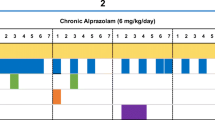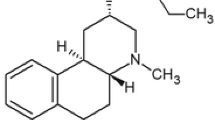Abstract
Classic neuroleptic drugs produce a syndrome of vacuous jaw movements in rats, and this syndrome has been offered as an animal model of early onset extrapyramidal side effects. The atypical antipsychotics do not produce elevations in vacuous jaw movements, or do so only at very high doses. The purpose of the present study was to determine the impact of the putative antipsychotic, amperozide, on vacuous jaw movements in rats. Groups of rats received daily injections of haloperidol (0.2, 0.4, or 0.8 mg/kg), clozapine (2.0, 4.0, 8.0 mg/kg), amperozide (2.0, 4.0, 8.0 mg/kg) or vehicle for 4 weeks. Once per week, rats were observed for the presence of vacuous jaw movements. Haloperidol increased vacuous jaw movements with increasing doses. Clozapine only produced elevations in vacuous jaw movements at the highest dose. In contrast, increasing doses of amperozide resulted in decreasing vacuous jaw movements for this portion of the dose-response curve. This is the first report of the effect of amperozide on vacuous jaw movements and results are discussed in terms of a potentially unique behavioral profile with respect to this behavior.
Similar content being viewed by others
Author information
Authors and Affiliations
Additional information
Received: 22 February 1996/Final version: 15 December 1997
Rights and permissions
About this article
Cite this article
Steinpreis, R., Moser, L., Parret, F. et al. The effects of the atypical antipsychotic amperozide on vacuous jaw movements in rats: a novel dose response profile. Psychopharmacology 138, 107–113 (1998). https://doi.org/10.1007/s002130050652
Issue Date:
DOI: https://doi.org/10.1007/s002130050652




